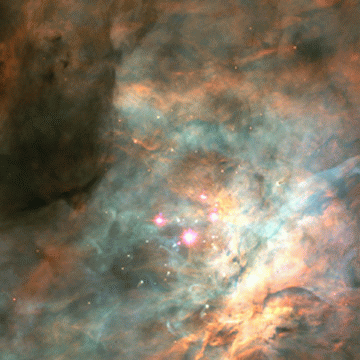The Orion Nebula -- A Stellar Nursery
Astronomers have long known that the Orion Nebula has been and is giving birth to stars. Distance and the brightness of stars within the nebula have made it difficult to observe every aspect of star birth taking place in this region. The nebula lies 1,500 light years away, and is really a cloud of gas and dust, illuminated by the light of its children. Even now, stars are forming here, and it may well be that planets are not far behind.
To study the complex interactions within such nebulae, have turned to orbiting observatories. With infrared telescopes, and the good views afforded by equipment onboard the Hubble Space Telescope, we can observe the process of stellar formation with enhanced eyes.
The image below-- taken with the Hubble Space Telescope -- shows but a tiny part of this huge nebula. Embedded within the clouds of molecular hydrogen and interstellar dust grains are stars in the process of creation -- protostars, as well as brightly-shining newborn stars, and disks of material called "proplyds" surrounding some infant stars. These proplyds may be the birthplaces of planetary systems.

No one is quite sure what causes these clouds to coalesce and begin the long and stormy period of star formation. Perhaps the gravitation of a passing star compresses a region within a nearby nebula, beginning a process that takes millions of years. Or, it's possible that the processes of stardeath might play a part in the birth of stars.